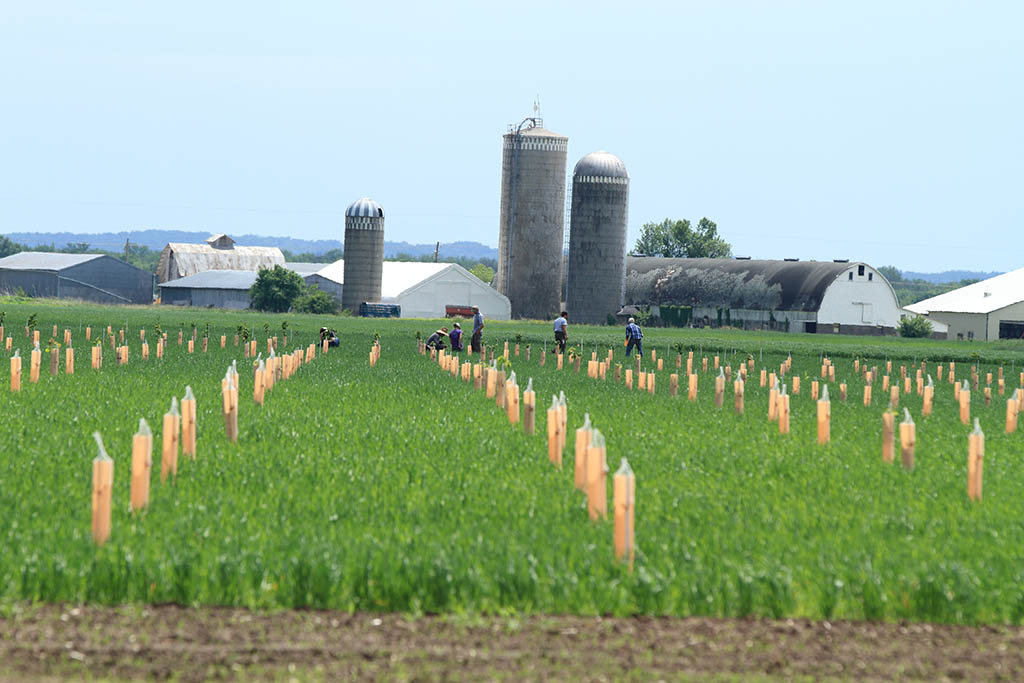In our latest podcast episode, Savanna Institute researchers Eliza Greenman and Nate Lawrence discuss the pros, cons, and tradeoffs of windbreak and riparian forest buffer management for ecosystem services and profitability during their session at the 2024 Perennial Farm Gathering.
Transcript has been edited for brevity and clarity
Eliza Greenman: Hi, everybody. So we’re going to talk about windbreaks and riparian buffers. What are the pros? What are the cons? From an ecosystem services perspective, from a profitability perspective?
There’s nothing new about windbreaks, that’s for sure. In the 1930s and ‘40s there was lots of tillage, the Dust Bowl happened, and so a lot of windbreaks were planted.
Nate Lawrence: As Eliza said, windbreaks are pretty established. If we think about which agroforestry practices are currently most well-represented in our landscapes, especially here in the Midwest, windbreaks probably rise to the top of that list. So that’s a good thing. But on the flipside, a lot of these windbreaks are very old. Some of them are only half functional. Many are being removed across almost all of the Midwest. They are probably being removed at a much greater clip than they are being planted. So if we think about windbreak cover on the landscape, we’re trending in the wrong direction.
Riparian buffers are kind of like windbreaks in that they’re edge-of-field practices often funded by the NRCS, in this case to protect water quality. Riparian buffers are expanding across much of the Midwest. That’s good news. But most riparian buffers planted in the Midwest today do not include trees or shrubs, so we can’t include them in our agroforestry tally because they don’t include woody plants.
We do have to be careful, especially if we’re thinking about riparian buffer management for productivity. This space was removed from production precisely because of its proximity to aquatic systems and because it’s a sensitive space, right? So if we start doing a lot of work or dumping a lot of inputs into a sensitive space, we may compromise the entire point of having a riparian buffer to begin with.
Eliza Greenman: Or with windbreaks – you know, windbreaks are to break the wind. And so what’s good there are evergreens – not deciduous trees that lose their leaves. And they really don’t thrive all that well in the face of wind. They’ll be stunted by wind, they won’t produce as much, they lose their hard hardiness if they’re in full wind. So think about planting another row of trees first before you plant any trees for production.
Nate Lawrence: When I got hired by the Savanna Institute as a researcher, I became kind of obsessed with how we grow trees in America today. How are our tree crops grown? What is the impact of the tree crops that we grow today?
The good news is that for pretty much any tree crop you can think of, there are people out there growing it in a very well-managed, intentional, integrated system that is super sustainable, that’s providing climate benefits, water benefits, biodiversity benefits, and is also profitable.
The bad news is that’s not really the norm for any of them. At least not for any woody crop that’s grown on more than a few hundred acres. When we grow woody perennial tree crops with a lot of inputs, we pretty well compromise most of the ecological outcomes that we’d like to see from these systems. So as we think about bringing new tree crops to the fold, we also need to be thinking about what we’re doing to not reinvent that crappy wheel that exists in a lot of other woody crops.
Eliza Greenman: In the history of tree crops in the United States, there have been a lot of snake oil salesmen. Like with mulberries. That industry has collapsed four times over 200 years. There were millions of mulberries planted across the country, and people thought they would make a fortune off of silk. But then nobody knew how to raise silkworms on the mulberries, and the industry collapsed. So they tried and failed and they tried and failed. Catalpa trees were another one. It was going to be the “fence post of the future”! But it failed (because they were growing the northern Catalpa, not southern Catalpa, and then they hybridized and that messed everything up).
So that’s all just to say, I can hype a tree crop all day long, and probably convince all of you to grow it eventually, but thankfully I’m surrounded by people who are constantly checking what I’m saying, either with science, or because they understand the markets and the industry and what’s going on. And so somebody like me needs that, and I have that. And Nate is one of these people who’s always got a suspicious eye.
Nate Lawrence: Originally I might have thought of my role here as promoting agroforestry. And I think I’ve come to realize, and become more excited about the idea that my role has more to do with improving agroforestry and finding opportunities where we could be doing better. And sometimes that involves finding and daylighting challenges and then finding ways to overcome them. I think it’s important to know whenever we are advocating for something that we do so in a way that’s responsible, that we’re going to feel good about in ten years. So it’s good having an audience of people who have a pretty good B.S. meter.

One-On-One Support for Farm Planning
Technical Assistance Program
Get help planning your perennial farm system. Our Technical Assistance Program is here to guide you through the process of planning, funding, and planting trees on your farm.


